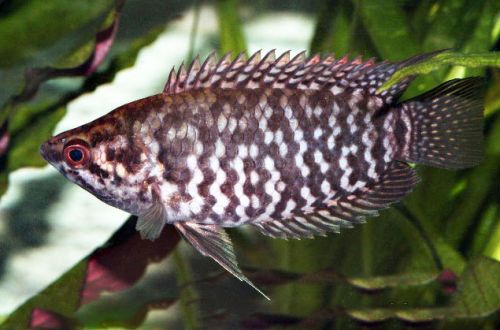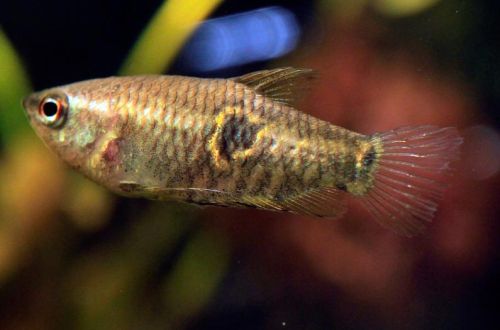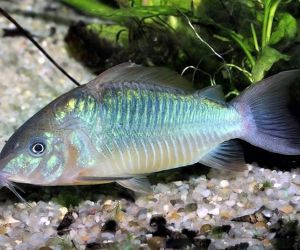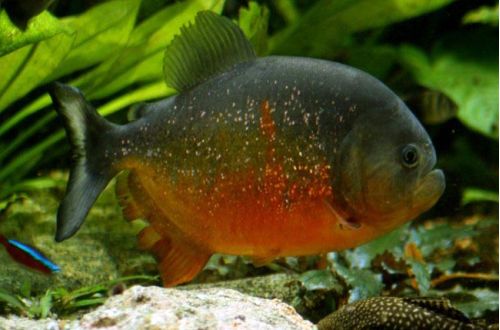
Ctenopoma eight-banded
The eight-striped ctenopoma, scientific name Microctenopoma fasciolatum, belongs to the Anabantidae family. Representative of African labyrinth fish. Easy to keep and breed, compatible with most peaceful fish, which, coupled with the original coloration, makes it an excellent candidate for the general aquarium.

Contents
Habitat
It originates from the African continent from the Congo River basin from the territory of the modern states of the Republic of the Congo and the Democratic Republic of the Congo, and is also found in several river systems in Cameroon.
Brief information:
- The volume of the aquarium – from 70 liters.
- Temperature – 24-28°C
- Value pH — 6.5–7.5
- Water hardness – soft to hard (4-20 dGH)
- Substrate type – any
- Lighting – subdued / moderate
- Brackish water – no
- Water movement – little or no
- The size of the fish is up to 8 cm.
- Meals – mostly meat
- Temperament – conditionally peaceful
- Keeping alone or in pairs male / female
Description
Adult individuals reach a length of up to 8 cm. Dark irregular vertical stripes are present in the body pattern. The coloration is changeable and varies from gray to dark brown, the fins often have a blue tint. The color scheme depends on the region of origin and the age of the fish, the juveniles look less colorful, the stripes appear weakly.
Food
Prefers live or frozen meat products of a suitable size, such as bloodworms, daphnia, brine shrimp. Dry food can be used as a supplement and rarely becomes the mainstay of the diet. However, some breeders have successfully adapted fish to such foods, which greatly simplifies maintenance, so this point should be clarified with the seller before buying.
Maintenance and care, maintenance of the aquarium
The optimal size of the aquarium for one pair of fish starts from 70 liters. The design is arbitrary subject to several conditions, namely the presence of dense thickets of plants, including floating ones, a muffled or moderate level of illumination, a tight cover with lamps and wires isolated from water and splashes.
The lid prevents fish from accidentally jumping out, and also helps to maintain a warm and humid air layer above the surface, which is necessary for the breathing of labyrinth fish.
Otherwise, Ktenopoma eight-banded is unpretentious and does not make special demands on its content.
Maintenance comes down to regular cleaning of the soil from organic waste and weekly replacement of part of the water (10-15% of the volume) with fresh water in the presence of an effective filtration system.
Behavior and Compatibility
Calm peaceful species, compatible with many fish of similar size and temperament. Overly active fish should be avoided, such as the Sumatran Barbus, which can intimidate Ctenopoma.
Intraspecific relationships are built on the dominance of the male in a certain territory, this is especially pronounced during the mating season, so skirmishes between them are not uncommon. It is recommended to keep in a pair of male / female, or in a group of a harem type.
Breeding / breeding
The appearance of offspring is possible in a common aquarium throughout the year. An additional stimulus can be a gradual change in pH to values of 5.5–6.0. With the beginning of spawning, the male builds an air-foam nest in thickets of floating plants, where he later invites the female to lay eggs, in total several hundred will be released. The incubation period lasts about 24 hours, and after another 2-3 days, the fry that have appeared will begin to swim freely. Parents calmly treat juveniles and do not show predation, so they can grow together. However, if other fish are present in the aquarium, it is advisable to transplant the fry into a separate tank with identical water conditions.
Fish diseases
The main cause of most diseases is unsuitable living conditions and poor-quality food. If the first symptoms are detected, you should check the water parameters and the presence of high concentrations of hazardous substances (ammonia, nitrites, nitrates, etc.), if necessary, bring the indicators back to normal and only then proceed with treatment. Read more about symptoms and treatments in the Aquarium Fish Diseases section.





